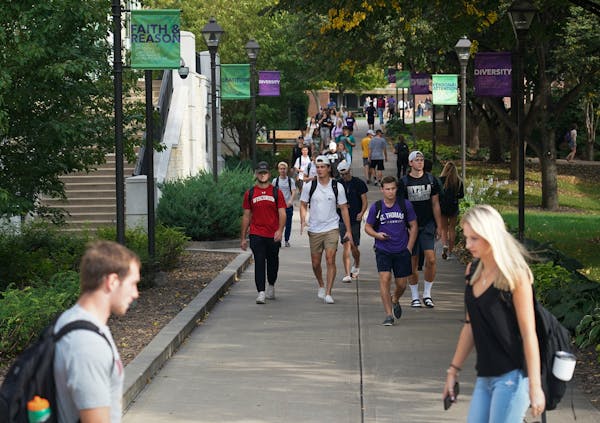A University of St. Thomas student was behind a series of hoax bomb threats since April, the most recent being phoned in last week, targeting buildings on the St. Paul campus where he had class on each of those three days, according to federal charges filed Monday.
Raymond G. Persaud, 20, of Blaine was charged in federal court in Minneapolis with a felony in connection with the threats he called in on April 17, Aug. 20 and Sept. 17. Persaud appeared in court hearing Tuesday afternoon and was ordered to remain in custody ahead of a detention hearing on Friday.
Persaud is a third-year undergraduate student at St. Thomas who commuted from his family's home, according to St. Thomas President Julie Sullivan.
Sullivan said Persaud has been suspended and barred from being on St. Thomas' campuses in St. Paul and Minneapolis pending a school investigation.
"If found responsible," she said, "he will face immediate expulsion from St. Thomas."
The FBI task force investigator noted that "bomb threats to educational institutions are sometimes phoned in by students seeking to avoid examinations or assignments," according to the criminal complaint.
The investigator found that Persaud had classes in buildings he mentioned on each of the days he made his threatening morning phone calls.
Mohendra Persaud told the Star Tribune that law enforcement officers arrested his son Tuesday morning at the family's home, but they did not explain why. The father said he was reluctant to say more and was preparing to attend his son's hearing.
Raymond Persaud attended schools throughout his youth in the Anoka-Hennepin School District and graduated in 2017 from Blaine High School, where he played football for three seasons, according to information provided by the district.
According to federal prosecutors:
On April 17, Persaud called St. Thomas and said there was a bomb on the St. Paul campus, specifically mentioning McNeely Hall. He called the university three times that morning making bomb threats. In response, the university evacuated and closed the entire campus, including a child-care center located in one of the buildings.
"Caregivers wheeled infant children still in their cribs out of the building and onto the sidewalk in order to remove the children from the danger zone," the criminal complaint read.
The FBI determined that the calls came from a Voice over Internet Protocol (VoIP), which allows users to have multiple telephone numbers.
On Aug. 20, Persaud again called St. Thomas via VoIP and said there was a bomb in the John Roach Center, a classroom building, which was then evacuated and closed for the day. Some of the classes were holding final examinations that day.
On Sept. 17, Persaud called using VoIP multiple times and stated there were bombs in the O'Shaughnessy Science Hall, the John Roach Center, the Anderson Student Center and the Facilities and Design Center. All four buildings were evacuated. Investigators were able to trace the origin of the calls to his family's home.
In each case, searches on campus turned up no suspicious items connected to the calls.
"I am very relieved that a suspect has been identified and arrested and that our community is not in danger from these hoax threats," Sullivan said.
Colleges and schools both locally and across the nation are confronting campus threats, some of which have been deemed unfounded by law enforcement. It's still unclear whether school officials have seen an upward trend in threats. In any event, St. Thomas officials and other college leaders are sharing tips on how to address such incidents and find the people behind them.
Paul Walsh • 612-673-4482

Trail section at one of Minnesota's most iconic spots closing for rehab

Will 'shotgun only' zone for deer in southern Minnesota be abolished?

Four Minnesotans catch salmonella in outbreak linked to basil sold at Trader Joe's

